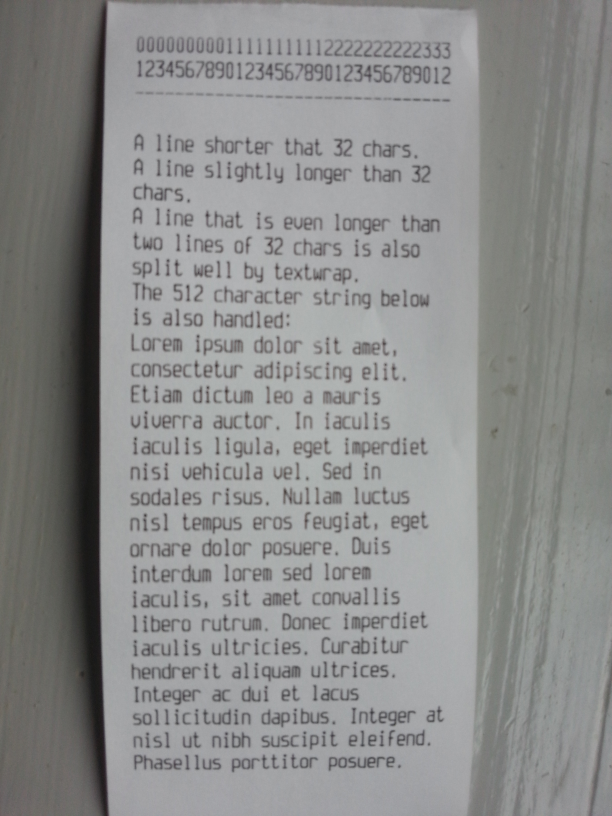Wiki
Clone wikiPipsta / Formatting Text with Textwrap
Overview
This bulletin describes a method of formatting simple text sent to the printer such that words are not split over two lines.
Background
The BasicPrint.py example prints simple text to the Pipsta's paper roll. By default, Pipsta prints 32 characters per line. The Pipsta printer does not attempt to intelligently split text sent to it: it simply continues to print characters on the next line. The result is that words often straddle two lines, reducing readability and impacting the aesthetic of the resultant print-out.
A standard Python module called 'textwrap' can however intelligently process simple text to wrap at a specified number of characters whilst also ensuring that only whole words will be printed on a line. This improves the readability of simple text print jobs with no significant coding overhead for the user.
Example
A new script, textwrap_example.py has been added to the repository as of 13th January 2016. If your git clone or download pre-dates this, you may wish to get an update of the repository now. For convenience, however, this script is also shown in full below:
#!python # textwrap_example.py # $Rev$ # Copyright (c) 2016 Able Systems Limited. All rights reserved. '''This simple code example is provided as-is, and is for demonstration purposes only. Able Systems takes no responsibility for any system implementations based on this code. The BasicPrint.py example prints simple text to the Pipsta's paper roll. By default, Pipsta prints 32 characters per line. The Pipsta printer does not attempt to intelligently split text sent to it: it simply continues to print characters on the next line. A standard Python module called 'textwrap' *can* however intelligently process simple text to wrap at a specified number of characters whilst also ensuring that only whole words will be printed on a line. This improves the readability of simple text print jobs with no coding overhead for the user. Copyright (c) 2016, Able Systems Ltd. All rights reserved. ''' import argparse import platform import struct import sys import time import os import inspect import textwrap import usb.core import usb.util example_strings = [ '00000000011111111112222222222333', '12345678901234567890123456789012', '--------------------------------', ' ', 'A line shorter that 32 chars.', 'A line slightly longer than 32 chars.', 'A line that is even longer than two lines of 32 chars is also split well by textwrap.', 'The 512 character string below is also handled:', 'Lorem ipsum dolor sit amet, consectetur adipiscing elit. Etiam dictum leo a mauris viverra auctor. In iaculis iaculis ligula, eget imperdiet nisi vehicula vel. Sed in sodales risus. Nullam luctus nisl tempus eros feugiat, eget ornare dolor posuere. Duis interdum lorem sed lorem iaculis, sit amet convallis libero rutrum. Donec imperdiet iaculis ultricies. Curabitur hendrerit aliquam ultrices. Integer ac dui et lacus sollicitudin dapibus. Integer at nisl ut nibh suscipit eleifend. Phasellus porttitor posuere.' ] # USB specific constant definitions PIPSTA_USB_VENDOR_ID = 0x0483 PIPSTA_USB_PRODUCT_ID = 0xA053 CR = b'\x0D' PIPSTA_LINE_CHAR_WIDTH = 32 FEED_PAST_TEAR_BAR = b'\n' * 5 def setup_usb(): '''Connects to the 1st Pipsta found on the USB bus''' # Find the Pipsta's specific Vendor ID and Product ID (also known as vid # and pid) dev = usb.core.find(idVendor=PIPSTA_USB_VENDOR_ID, idProduct=PIPSTA_USB_PRODUCT_ID) if dev is None: # if no such device is connected... raise IOError('Printer not found') # ...report error try: dev.reset() # Initialisation. Passing no arguments sets the configuration to the # currently active configuration. dev.set_configuration() except usb.core.USBError as err: raise IOError('Failed to configure the printer', err) # Get a handle to the active interface cfg = dev.get_active_configuration() interface_number = cfg[(0, 0)].bInterfaceNumber usb.util.claim_interface(dev, interface_number) alternate_setting = usb.control.get_interface(dev, interface_number) intf = usb.util.find_descriptor( cfg, bInterfaceNumber=interface_number, bAlternateSetting=alternate_setting) ep_out = usb.util.find_descriptor( intf, custom_match=lambda e: usb.util.endpoint_direction(e.bEndpointAddress) == usb.util.ENDPOINT_OUT ) if ep_out is None: # check we have a real endpoint handle raise IOError('Could not find an endpoint to print to') return ep_out def main(): pipsta = setup_usb() for line in example_strings: print (textwrap.fill(line, PIPSTA_LINE_CHAR_WIDTH)) pipsta.write(textwrap.fill(line, PIPSTA_LINE_CHAR_WIDTH)) pipsta.write(CR) pipsta.write(FEED_PAST_TEAR_BAR) if __name__ == '__main__': main()
How it Works
NOTE: The script sends only simple text (i.e. no graphics) to the printer.
• The script firstly establishes a connection to the Pipsta printer over USB.
• The raw text strings are retrieved from a list:
#!python example_strings = [ '00000000011111111112222222222333', '12345678901234567890123456789012', '--------------------------------', ' ', 'A line shorter that 32 chars.', 'A line slightly longer than 32 chars.', 'A line that is even longer than two lines of 32 chars is also split well by textwrap.', 'The 512 character string below is also handled:', 'Lorem ipsum dolor sit amet, consectetur adipiscing elit. Etiam dictum leo a mauris viverra auctor. In iaculis iaculis ligula, eget imperdiet nisi vehicula vel. Sed in sodales risus. Nullam luctus nisl tempus eros feugiat, eget ornare dolor posuere. Duis interdum lorem sed lorem iaculis, sit amet convallis libero rutrum. Donec imperdiet iaculis ultricies. Curabitur hendrerit aliquam ultrices. Integer ac dui et lacus sollicitudin dapibus. Integer at nisl ut nibh suscipit eleifend. Phasellus porttitor posuere.' ]
• Each raw text line is passed through the textwrap function:
#!python textwrap.fill(line, PIPSTA_LINE_CHAR_WIDTH)
...where:
line is the raw text line,
PIPSTA_LINE_CHAR_WIDTH is defined as 32, this being the character at which textwrap will wrap the line.
• Thereafter, pipsta.write() sends data over USB to the printer for each line of text
• The print job is then fed out to the tear bar
Running the script, you will see that text sent to the printer is split into whole words on each line.
The result is as follows:

[END]
Updated